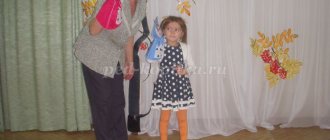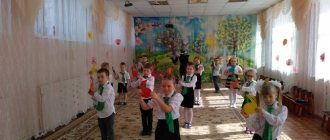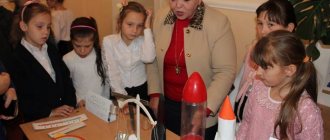Music lesson in the preparatory group “Listening to Music”
Introductory part
Topic: Listening to music. The visual nature of music.
Tasks:
- Introduce children to instrumental pieces.
- Learn to identify the two-part form of music.
- Strengthen the ability to convey the character of the work through movements.
Progress of the lesson
To the sound of marching music, children enter the hall, then perform exercises that reinforce expressive movement skills (springing, twirling, stamping with two feet) in pairs.
The music director sings: Hello, children! Answer: Hello!
Musical director: We’ll sit down, sit, and look at the pictures! (Pictures depicting sparrows and cars are attached to the magnetic board)
Musical director: Now let’s close our eyes, open our ears, listen carefully, imagine diligently!
(Listening to G. Fried’s musical work “Sparrows and the Car”)
Musical director:
- Guys, what is the character of our music?
- Who does the music sound like?
Look at the pictures and choose the one you need.
Now listen to the music again and show the desired picture that matches the first part of the piece and the desired picture that fits the second part of the piece. (children listen and show)
Musical director: What can you call our music? Children's answer...
Musical director: Now we’ll see how you can transform. When the first part sounds, you will depict the image of small birds in your movements, in the second part - the image of cars. (Children perform the appropriate movements) The music director praises the children.
Musical director: Now let’s remember what the nature of the play “Butterfly” is, which we listened to in the last lesson? Children's answer...
Musical director: Now tell me, is our music similar to the play “Butterfly”? Children's answer...
Also an interesting musical activity: GCD for musical activities (listening to music). Topic: Antoshka.
The game "Butterflies" is being played
Fake flowers the size of children are displayed (cornflower - blue, chamomile - white, dandelion - yellow, poppy - red), butterflies fly around the clearing to the song, to the words:
- Butterflies flew to a cornflower flower, a blue flower (the music stops, the butterflies gather in a circle around the desired flower, in this case it is a cornflower. The song about butterflies sounds again, with lyrics...);
- I met a daisy, cutie butterflies, a daisy flower, a white petal (the music stops, the butterflies gather around the desired flower, a daisy);
- The butterflies flew in and sat on the dandelion, the dandelion is the sun, the golden bottom (the music stops, the butterflies gather around the dandelion flower);
- The butterflies were flying, and they recognized the flower, it’s a red poppy - my friend, it’s like a festive flag (the music stops, the butterflies gather around the flower - a dandelion).
Musical director: Butterflies flew to the clearing and heard wonderful sounds.
"Spring Song" sounds.
Musical director: A song was played that conveys the spring mood and is similar in character to our sparrows and butterflies.
Repeat after me the words of this funny song:
The gentle sun, the sun of spring, The sun woke up a leaf from winter And the field woke up, and the forest woke up And under the warm sun, many miracles. (learning the first verse)
Musical director: And now, to light, graceful music, let’s try to express the spring mood in free dancing. (Children depict thawed butterflies, blades of grass growing and stretching upward, flying birds, awakened bear cubs, cheerful bunnies, the shining sun...)
Musical farewell: Goodbye children. Children: Bye to you.
Author: Kireeva Svetlana Borisovna Position: music director Place of work: MBDOU No. 299 Location: Krasnoyarsk
Characteristic
Musical and didactic games are one of the effective means of developing the musical culture of children in the preparatory group. With their help, it is possible to develop children's ear for music, a sense of rhythm and creative abilities.
Musical and didactic games for the preparatory group have many developmental factors for children.
It is thanks to such a program that with the help of games it is possible to teach children, which will allow them to assimilate, consolidate and systematize knowledge.
Numerous observations of children of senior preschool age have proven that children can play didactic games with peers without the help of adults, independently compose and invent a sequence of games.
Musical and didactic games for the preparatory group help children to be active and use the skills acquired in everyday life.
Musical and didactic games for the preparatory group - card index
This technique has a lot of advantages:
- it helps develop musical abilities;
- enriches the emotional world of children;
- develops cognitive abilities;
- fosters activity, discipline, and a sense of collectivism.
Musical and didactic games for the preparatory group are used by all group teachers who prepare children for school and they choose techniques that will help solve the tasks:
- Visual: visual-auditory and visual-visual. This technique is based on musical compositions that the child listens to, compares and contrasts. Auditory perception is reinforced by visual perception, for example, bright cards, musical toys and instruments are used.
- Verbal : during the lesson, the teacher explains, tells, talks, asks questions. The teacher, through dialogue, conveys to the children knowledge about music. Speech in this case has emotional and figurative content.
- Practical. The teacher plays musical instruments, sings, performs rhythmic movements, and then the children repeat after him.
Musical and didactic games for the preparatory group will be beneficial and will help to properly develop the child if these three methods are used in an increasing number of problems: from direct influence to consolidation, performing already familiar exercises and creating new situations.
Card index
Musical and didactic games for the preparatory group help only when the goals and objectives that one would like to achieve are clearly set. Each teacher has his own goals, but basically they are based on general rules.
These include:
- introduce your child to music;
- find creative potential and develop it;
- develop hearing and taste;
- develop musical and sensory abilities;
- instill in the child a love of independent activity in art.
Walk
Goal: to develop a child’s sense of rhythm. Materials for the game: musical hammers, cubes and sticks according to the number of participants.
Progress of the game:
The teacher warns the children taking part in the game that they are now going for a walk.
— Musical hammers will help you on your walk. Here we are going down the stairs, and at this moment the teacher hits his palms with hammers.
Children repeat the exact rhythmic pattern after the teacher.
- But now we went out into the street, where the bright sun was shining, everyone was very happy and ran. Like this!
The teacher conveys running with frequent blows of the hammer. The children repeat after him.
“Nastya took the ball in her hands and began to slowly throw it on the ground, carefully hitting her palm with a hammer.
Children repeat all movements again.
“The rest of the children quickly begin to jump,” and at the same time they hit their palms with hammers at a fast pace.
Everyone repeats the movements.
- And then out of nowhere there is a cloud and rain. At first it is slow - the hammer strikes are slow and monotonous.
- Then a heavy downpour began, - the blows on the palms were already stronger and faster.
“The children got scared and ran to hide from the rain in the kindergarten,” the hammers quickly hit their palms.
Any number of children can take part in this game. It is better to conduct the lesson in the evening.
Sunshine and rain
Goal: to help the child develop auditory attention. The child will be able to distinguish between long and short sounds.
Material for the game: circles of rich yellow color, symbolizing the sun, and these blue ones - clouds. You will need a drum or tambourine. How to play: There are two variations of this game and they are both described in the table below.
| Option | Description |
| First. Children are divided into 2 groups. | Children sit in front of the teacher. One group of children is given yellow circles - suns, and the second group is given clouds. A teacher with a drum or tambourine makes a sound. With a long sound, children with suns raise their hands up, and with a short sound, clouds. The teacher alternates sounds and makes sure that the children perform the movements correctly. At the end, the winning team is determined and gives the task to the loser. |
| Second. Children are also divided into 2 groups. | Children stand in a line at opposite walls of the room. The team that must distinguish a long sound when it walks in different directions. But children who can distinguish a short sound must run. When the opposite sound to the given sound is performed, the children remain in the place where the sound found them, and after the end of the sound, all children must line up. The winner is the team that lines up the fastest. |
Attentive little animals
Goal: to develop timbre hearing in children, as well as auditory attention. Equipment for the game: flat images of a hare, a bear and a fox - for each child, children's musical instruments: a rattle, a hammer and a tambourine.
Progress of the game:
Children are sitting at tables. In front of each of them are images of animals.
- Children, now your animals will go for a walk in the forest, but not all at once, but one by one. To do this, we listen to the instrument, if a tambourine sounds, then a bear will go for a walk, if a rattle - a fox, a rattle - a bunny.
The teacher plays different instruments, the children choose the appropriate animal and imitate its movements.
Learn to dance
Goal: develop a sense of rhythm. Equipment for the game: a large matryoshka doll and small ones in an amount corresponding to the number of participants.
Progress of the game:
The game is played with a small group of children. They are sitting at the table. The teacher has a large nesting doll, and the children have small ones. The teacher taps a simple rhythmic pattern on the table with a matryoshka doll, and then the children must repeat it. Tapping your nesting dolls. Then the child who has completed the task correctly can become the main player in the game.
Musical stairs
Goal: to develop a sense of rhythm in children.
Inventory for the game: you will need to prepare several separate stacks of cards of different colors. Each set should contain 6 pairs and in addition 12 cards and 4 separate piles.
Each pair contains a card with a ladder drawn, and cards with circles correspond to the steps of the ladder. Two pairs of cards with images of steps that go up and down, also two pairs of 4 steps and two more pairs of 5. You will also need a metallophone musical instrument.
Progress of the game:
Up to 7 children can take part in the game. You definitely need to choose a leader. It is the presenter who must divide all the cards equally between those present: the presenter places cards with circles in front of himself, and distributes cards with ladders equally to the players.
After the presenter shows a card with a circle, the children then sing the sounds in a certain order, down or up. When the presenter asks who has such a card, the child answers who has it in his hands. The one who gets paired cards first wins.
Loudly and quietly binge drinking
Goal: to help the child develop diatonic hearing. Equipment for the game: any toy.
Progress of the game:
Children must choose who will drive. He must leave the room, and everyone else agrees on where to hide the toy. The driver must find it, but he is guided by the volume of the sound.
For example, this could be a song that all the children sing together and its sound intensifies when the driver approaches the toy and fades away when he moves away. If the driver completed the task successfully, then he hides the toy next time.
Musical riddles
Goal: to develop a sense of rhythm in children. Material for the game: children's musical instruments: rattle, tambourine, metallophone, hammer, drum, triangle, bell.
Progress of the game:
Children sit in a semicircle in front of a screen, and musical instruments are stacked on a table behind it. A presenter is selected and must play a rhythmic pattern on any of the instruments behind a screen. Children must guess. The child who guessed correctly is given a chip. The one with the most chips wins.
A music shop
Goal: to develop the child’s creative abilities and sense of rhythm. Material for the game: children's musical instruments: tambourine, hammer, spoons, rattles, metallophone and others.
Progress of the game:
The buyer asks the seller to listen to how the instrument he has chosen sounds. The child acts as a seller and plays a simple rhythmic pattern, and then invites the buyer to try it himself. This game helps develop independent activity in a child.
Funny nesting dolls
Goal: to develop a child’s pitch hearing. Materials for work: nesting dolls of three separate sizes, metallophone.
Progress of the game:
Children are divided into three separate groups: one receives large nesting dolls, the second - medium ones, and the third - small ones.
“The children are about to start dancing with your nesting dolls.” But to do this you need to listen carefully to what sound will sound. If it is low, then small nesting dolls start dancing, if it is medium - medium, and high - large.
The dance consists of a slightly swaying doll in a raised hand. The teacher performs the sound, constantly changing the sequence of sounds. At the end the winning team is celebrated. Children can choose the song for the game themselves. Matryoshka dolls can be easily replaced with any other toys.
Music Box
Goal: to develop the child’s creativity and repeat all the material covered. Material for the game: you will need a beautiful and bright box (a box will do), cards with bright drawings that depict characters from familiar songs, games, and dances.
Progress of the game:
About 6 cards are placed in the box. Each child comes up, takes a card and passes it to the leader, and he must name the song, game or dance depicted on the card. The songs are then performed by all children, but without musical accompaniment. But after that the game takes place in the format of a concert.
Define a tool
Goal: to develop a child’s ear for timbre and sense of rhythm. Material for the game: you will need two sets of musical instruments and toys: spoons, hammers, metallophones, cubes, tambourines and more.
Progress of the game:
Two children sit with their backs to each other. Identical musical instruments are laid out in front of them. One child takes any instrument and performs a rhythmic pattern on it. The other one must repeat. If he did everything right, the other children applaud him. Afterwards, the child who guessed the melody asks his task, and if he makes a mistake, then he is given another one.
Musical lotto
Goal: to help the child develop creativity, memory, and repeat the entire stage. Material for the game: you need 3-4 cards, which show up to 4 pictures that correspond to the content of the song, and you will also need a second set of the same cards, but small ones.
Progress of the game:
2-4 children receive large cards and only one entire set of small ones. He shows one of the cards, and the child who has the same card must remember and sing 1 verse of the song. Afterwards he receives a small card and covers the picture with the large one. The one who closes the card faster wins.
Didactic games with musical accompaniment are developed for children of any age. It is thanks to them that the child better understands what is happening around him.
They also help to reveal the creative potential of each child, instill a love of music and solve a lot of problems with hearing and speech. They are especially important for preparatory groups, because children need to be ready for school.








